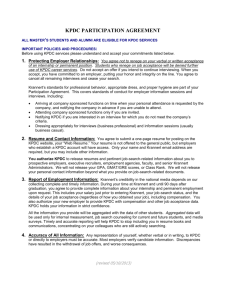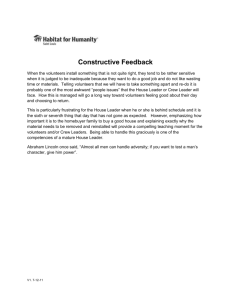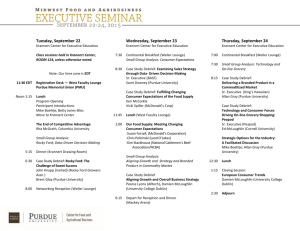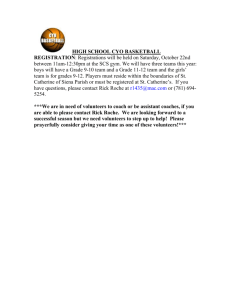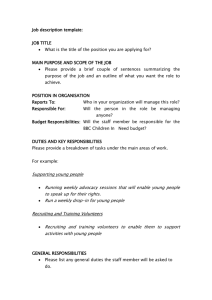Assessment Mini Grant Award Summary Report
advertisement
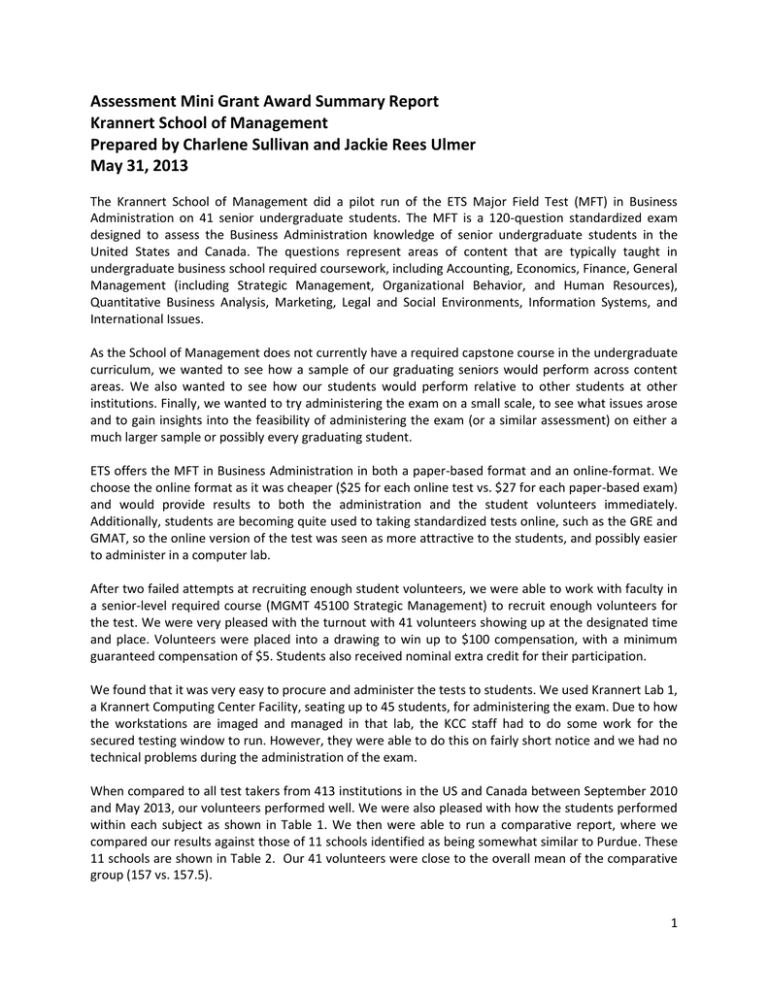
Assessment Mini Grant Award Summary Report Krannert School of Management Prepared by Charlene Sullivan and Jackie Rees Ulmer May 31, 2013 The Krannert School of Management did a pilot run of the ETS Major Field Test (MFT) in Business Administration on 41 senior undergraduate students. The MFT is a 120-question standardized exam designed to assess the Business Administration knowledge of senior undergraduate students in the United States and Canada. The questions represent areas of content that are typically taught in undergraduate business school required coursework, including Accounting, Economics, Finance, General Management (including Strategic Management, Organizational Behavior, and Human Resources), Quantitative Business Analysis, Marketing, Legal and Social Environments, Information Systems, and International Issues. As the School of Management does not currently have a required capstone course in the undergraduate curriculum, we wanted to see how a sample of our graduating seniors would perform across content areas. We also wanted to see how our students would perform relative to other students at other institutions. Finally, we wanted to try administering the exam on a small scale, to see what issues arose and to gain insights into the feasibility of administering the exam (or a similar assessment) on either a much larger sample or possibly every graduating student. ETS offers the MFT in Business Administration in both a paper-based format and an online-format. We choose the online format as it was cheaper ($25 for each online test vs. $27 for each paper-based exam) and would provide results to both the administration and the student volunteers immediately. Additionally, students are becoming quite used to taking standardized tests online, such as the GRE and GMAT, so the online version of the test was seen as more attractive to the students, and possibly easier to administer in a computer lab. After two failed attempts at recruiting enough student volunteers, we were able to work with faculty in a senior-level required course (MGMT 45100 Strategic Management) to recruit enough volunteers for the test. We were very pleased with the turnout with 41 volunteers showing up at the designated time and place. Volunteers were placed into a drawing to win up to $100 compensation, with a minimum guaranteed compensation of $5. Students also received nominal extra credit for their participation. We found that it was very easy to procure and administer the tests to students. We used Krannert Lab 1, a Krannert Computing Center Facility, seating up to 45 students, for administering the exam. Due to how the workstations are imaged and managed in that lab, the KCC staff had to do some work for the secured testing window to run. However, they were able to do this on fairly short notice and we had no technical problems during the administration of the exam. When compared to all test takers from 413 institutions in the US and Canada between September 2010 and May 2013, our volunteers performed well. We were also pleased with how the students performed within each subject as shown in Table 1. We then were able to run a comparative report, where we compared our results against those of 11 schools identified as being somewhat similar to Purdue. These 11 schools are shown in Table 2. Our 41 volunteers were close to the overall mean of the comparative group (157 vs. 157.5). 1 Table 1: Krannert Student Volunteer Results Assessment Indicator Number Assessment Indicator Title Krannert Mean Percent Correct Mean Percent Correct of all Exam Takers 1 Accounting 52 43.9 2 Economics 49 44.3 3 Management 58 57.2 4 Quantitative Business Analysis 53 5 Finance 56 42.8 6 Marketing 55 55.2 7 Legal and Social Environment 57 8 Information Systems 50 48.4 9 International Issues 54 52.8 Table 2: Institutions in Comparable Set School Name Ball State University, IN Boston College, MA Florida State University, FL Georgia State University, GA Northeastern University, MA Oklahoma State University, OK Tulane University, LA University of Florida, FL University of Nebraska – Lincoln, NE University of Oklahoma, OK Washington State University – Pullman, WA 40.6 55.6 Number of Students 555 263 33 3,169 337 405 337 1,511 1,513 200 567 On the subject assessment, our little group did slightly better in accounting (52 vs. 51.5), very slightly worse in economics (49 vs. 50.2), worse in management (58 vs. 61.6), far better in quantitative business analysis (53 vs. 43.9), better in finance (56 vs. 53.1), worse in marketing (55 vs. 61.3), very slightly worse in legal and social environment (57 vs. 57.2), worse in information systems (50 vs. 54.5) and worse on international issues (54 vs. 58.5). While our student volunteers comprise a very small and self-selected sample, and therefore we cannot make many inferences on the quality of our programs nor of the quality of our students based on this experiment, we have generated a number of action items based on these results. The first is that we will have representative faculty review the contents related to their subject matter, to see if the questions on the test are representative of how our courses are taught on the West Lafayette campus. It could be that we take a different approach to the subject matter and our approach is entirely appropriate given 2 our mission. Another metric of student achievement, our internship and full-time placement rates are very high, particularly in information systems, so it could be that there is a mismatch between our curriculum and test, and we should not make any changes based on these results. The international issues subarea is the one that is likely to get our greatest attention. We have found through our Assurance of Learning assessments that we could be broader and deeper in how we incorporate international issues in our required courses. Our upcoming EQUIS accreditation review and the implementation of the embedded outcomes of the University’s Outcome-based Core Curriculum also indicate that we need work with instructors to identify more opportunities to engage our undergraduates on this outcome. This experiment will also seed discussions of curriculum change in terms of whether to add a capstone course to our undergraduate majors and/or whether a required senior assessment would be appropriate. A senior capstone course would be attractive to recruiters and students. However, there would be significant instructor resources required in an already highly constrained environment. A required assessment exam for graduating seniors would also have resource and logistic requirements. We would likely have to switch back to the paper-based format due to the availability of workstations on campus. There is a substantial cost to administering the test to every graduating senior ($27 per test this year). A question that has come up at assessment seminars run by the AACSB has been getting students to take the test seriously, even if it is required for graduation. In order to achieve this, we would likely have to build a 1-credit course around the test, which adds to student expense and burden, which we are highly cognizant of. Even a 1 credit course, where the performance on the test would be somehow tied to a course grade, may not be enough to incentive students to perform well, given the nominal impact on GPA at that point in the academic career. Finally, the test itself is problematic. Adopting the ETS (or any other non-Krannert) instrument could result in the curriculum being “steered” toward performance on a third-party test or “teaching to the test” which would cause heated discussion and has a very high likelihood of non-acceptance by the Krannert Faculty. Building our own assessment test would be an option, but again would be time-consuming and would present the same logistic and student incentive issues as discussed above. 3
